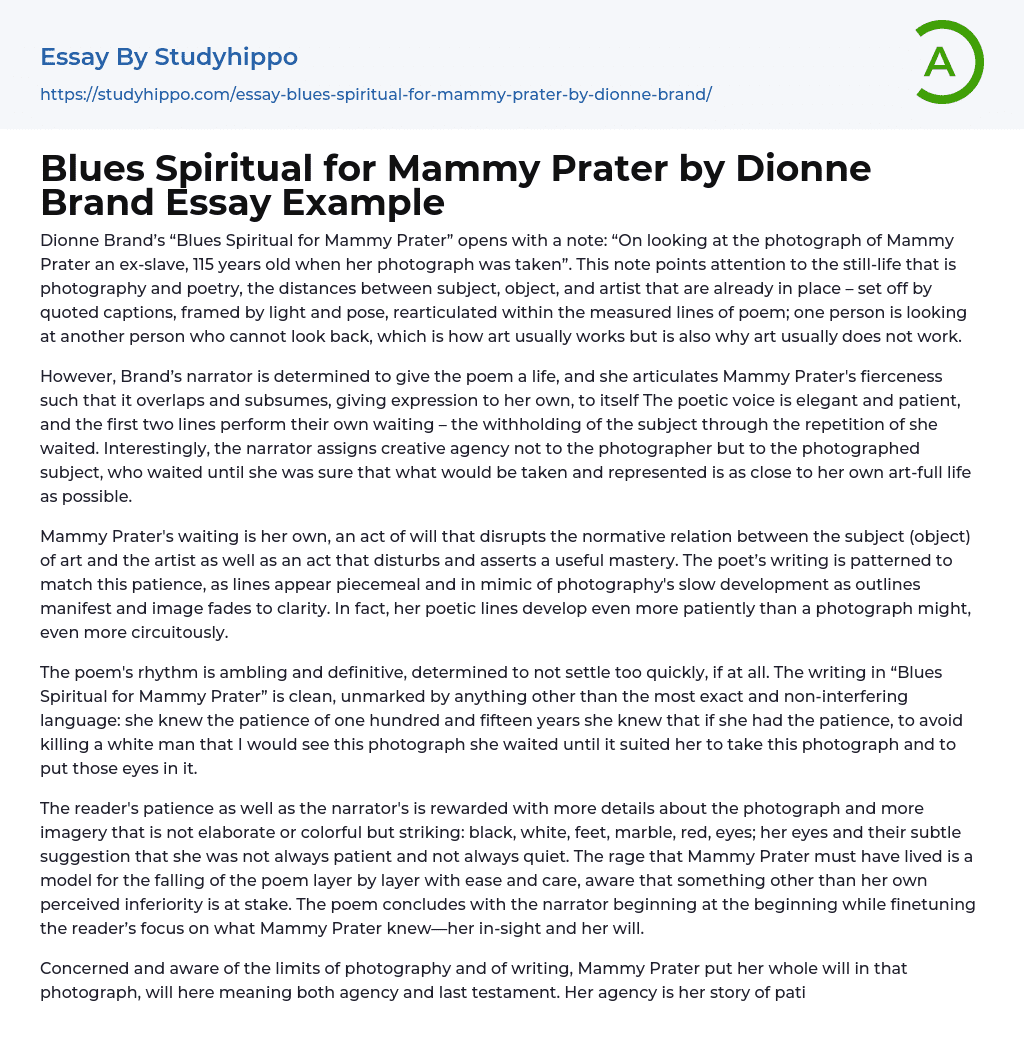

Blues Spiritual for Mammy Prater by Dionne Brand Essay Example
Dionne Brand’s “Blues Spiritual for Mammy Prater” opens with a note: “On looking at the photograph of Mammy Prater an ex-slave, 115 years old when her photograph was taken”. This note points attention to the still-life that is photography and poetry, the distances between subject, object, and artist that are already in place – set off by quoted captions, framed by light and pose, rearticulated within the measured lines of poem; one person is looking at another person who cannot look back, which is how art usually works but is also why art usually does not work.
However, Brand’s narrator is determined to give the poem a life, and she articulates Mammy Prater's fierceness such that it overlaps and subsumes, giving expression to her own, to itself The poetic voice is elegant and patient, and the first two lines perfo
...rm their own waiting – the withholding of the subject through the repetition of she waited. Interestingly, the narrator assigns creative agency not to the photographer but to the photographed subject, who waited until she was sure that what would be taken and represented is as close to her own art-full life as possible.
Mammy Prater's waiting is her own, an act of will that disrupts the normative relation between the subject (object) of art and the artist as well as an act that disturbs and asserts a useful mastery. The poet’s writing is patterned to match this patience, as lines appear piecemeal and in mimic of photography's slow development as outlines manifest and image fades to clarity. In fact, her poetic lines develop even more patiently than a photograph might, even more circuitously.
The poem's rhythm is amblin
and definitive, determined to not settle too quickly, if at all. The writing in “Blues Spiritual for Mammy Prater” is clean, unmarked by anything other than the most exact and non-interfering language: she knew the patience of one hundred and fifteen years she knew that if she had the patience, to avoid killing a white man that I would see this photograph she waited until it suited her to take this photograph and to put those eyes in it.
The reader's patience as well as the narrator's is rewarded with more details about the photograph and more imagery that is not elaborate or colorful but striking: black, white, feet, marble, red, eyes; her eyes and their subtle suggestion that she was not always patient and not always quiet. The rage that Mammy Prater must have lived is a model for the falling of the poem layer by layer with ease and care, aware that something other than her own perceived inferiority is at stake. The poem concludes with the narrator beginning at the beginning while finetuning the reader’s focus on what Mammy Prater knew—her in-sight and her will.
Concerned and aware of the limits of photography and of writing, Mammy Prater put her whole will in that photograph, will here meaning both agency and last testament. Her agency is her story of patient artistry, a story that becomes an unending gift to the narrator and writer, a poem delivered with perfect photographic velocity. This spiritual of Mammy Prater does not aim to capture her voice but, instead, in its stillness, works to give flesh and movement to a woman whose patience, will, and determination for perfection transcended
photography and writing (language) and yielded her connection to an/other woman yet to come.
- Book Summary essays
- Metaphor essays
- Reader essays
- Rhyme essays
- Literary devices essays
- Villain essays
- Books essays
- Genre essays
- Literary Criticism essays
- Writer essays
- Protagonist essays
- Simile essays
- Poem essays
- Book Report essays
- Book Review essays
- Greek Mythology essays
- Plot essays
- Tragic Hero essays
- Coming of Age essays
- Play essays
- Rhetoric essays
- Rhetorical Question essays
- Translation essays
- Understanding essays
- Reason essays
- Character essays
- Letter essays
- American Literature essays
- Literature Review essays
- Utopia essays
- Poetry Analysis essays
- Dante's Inferno essays
- Between The World and Me essays
- Incidents in The Life of a Slave Girl essays
- Flowers for Algernon essays
- Myth essays
- Everyday Use essays
- Boo Radley essays
- Genesis essays
- Richard iii essays
- Alice in Wonderland essays
- On the road essays
- Ozymandias essays
- The Nightingale essays
- Holden Caulfield essays
- Animal Farm essays
- 1984 essays
- A Hanging essays
- Shooting An Elephant essays
- A Tale Of Two Cities essays



